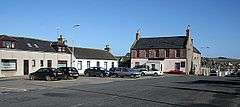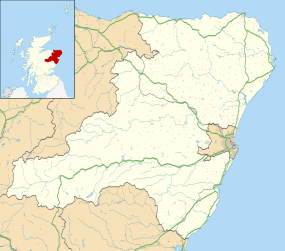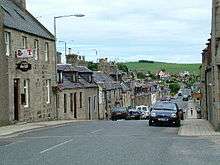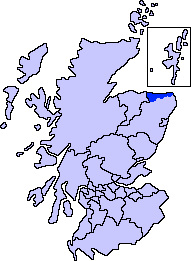Aberchirder
| Aberchirder | |
| Scottish Gaelic: Obar Chiardair | |
| Scots: Foggieloan/Aberchirder | |
 |
|
 Aberchirder |
|
| Population | 1,149 [1] (2001 census) est. 1,200[2] (2006) |
|---|---|
| OS grid reference | NJ624522 |
| Council area | Aberdeenshire |
| Lieutenancy area | Banffshire |
| Country | Scotland |
| Sovereign state | United Kingdom |
| Post town | HUNTLY |
| Postcode district | AB54 7xx |
| Dialling code | 01466 780 |
| Police | Scottish |
| Fire | Scottish |
| Ambulance | Scottish |
| EU Parliament | Scotland |
| UK Parliament | Banff and Buchan |
| Scottish Parliament | Banffshire and Buchan Coast |
Coordinates: 57°33′30″N 2°37′48″W / 57.55832°N 2.63004°W
Aberchirder (Scottish Gaelic: Obar Chiardair, Scottish Gaelic pronunciation: [ˈopəɾˈçiəɾt̪əɾʲ]), known locally as Foggieloan or Foggie, is a village in Aberdeenshire, Scotland, situated on the A97 road six miles west of Turriff.
History

The village of Aberchirder was founded in 1764 by Alexander Gordon, the 5th laird of Auchintoul. Until 1823 its official name was, in fact, Foggieloan after a small farm community on the site of which it was built.[3] There is some uncertainty as to how the name Foggieloan originated. There are various theories; the most likely is that there is a stretch of moorland north of where the farm town existed (and, now, north of the village) which was named Foggieloan Moss from two Gaelic words foidh (peat moss) and lòn (meadow), so Foggieloan means peaty or boggy meadow. Kinnairdy Castle, now belonging to the Innes family is 2 miles to the south west, where the River Deveron joins the Auchintoul Burn. In 1823 the village was renamed Aberchirder after the 13th century Thanes of Aberkerdour of Kinnairdy Castle.[4]
As a planned community, the village was built on a grid pattern around a central square and had a mix of single storey thatched, stone-built houses fronting onto the streets (to prevent people having their middens on show) with long gardens intended to provide the inhabitants with a seasonal supply of food. Alexander Gordon envisaged a thriving industrial village and built a small linen factory in Back Street (now North Street) which produced fine linen table-cloths and wincey using flax from Auchintoul Moss. By the late 19th century, wealthier inhabitants had built some grander houses and there was a selection of religious establishments throughout the town catering to various denominations in addition to the Church of Scotland and Free Church buildings.[5]
References
- ↑ "Comparative Population Profile: Aberchirder Locality". Scotland's Census Results Online. 2001-04-29. Retrieved 2008-08-31.
- ↑ http://www.gro-scotland.gov.uk/statistics/publications-and-data
- ↑ Peden, Bob (2010). Old Aberchirder. Catrine, Ayrshire: Stenlake Publishing. p. 3. ISBN 9781840335057.
- ↑ Peden, Bob (2010). Old Aberchirder. Catrine, East Ayrshire: Stenlake Publishing. p. 3. ISBN 9781840335057.
- ↑ Peden, Bob (2010). Old Aberchirder. Catrine, Ayrshire: Stenlake Publishing. p. 3. ISBN 9781840335057.
- AA Touring Guide to Scotland (1978)
External links
| Wikimedia Commons has media related to Aberchirder. |
- Foggieloan
- Gazetteer for Scotland, 2002-2004: Aberchirder
- Gazetteer for Scotland, 2002-2004: Aberchirder history

